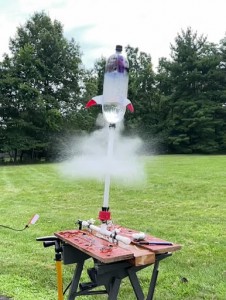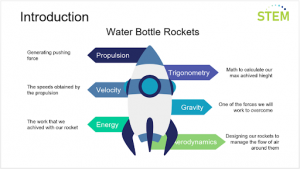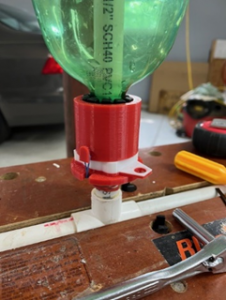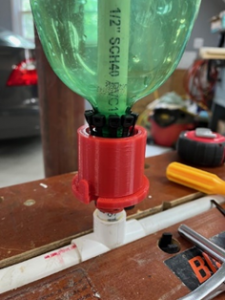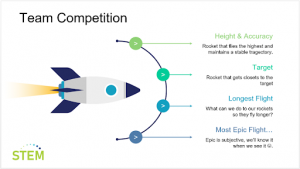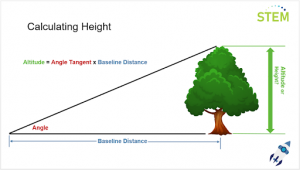One of our Apple Rubber Engineers had the opportunity to lead a STEM class (Science, Technology, Engineering, and Mathematics) for Junior and Senior High School students last month. Their project was based on Water Bottle Rockets. The students were in Junior High, so they had no previous understanding of Newton’s Laws of Motion, nor knowledge of Algebra and Trigonometry. Below is a slide of the primary topics covered.
A launcher was made using ½ inch PVC pipe. A latch mechanism was created using zip ties, a hose clamp, and various 3D printed parts. A bicycle pump with a gauge provided air pressure. The ½ inch PVC pipe fits snugly inside of the mouth of a 2-liter bottle. However, an Apple Rubber O-ring was needed to ensure that there was no leakage. The Apple Rubber O-ring Gland Calculator was used to determine that an AS568-017 o-ring was the best size and produced the recommended gland dimensions that were then machined into the PVC pipe.
Of course, every activity is more enjoyable when it is a competition. The students were paired into teams. The slide below shows the three challenges and a bonus of “Most Epic Flight.”
To measure and calculate the height, trigonometry was introduced. The students learned about triangles with right angles. In this case, the Height (opposite) was calculated by multiplying the Baseline Distance (adjacent) with the Tangent Angle.
Estes makes a neat handheld device called an Altitrak, Altitude Finder. It comprises a Sight, Trigger, Angle Scale, and Swingarm. The students practiced using this device to measure the height of a building and a tree by standing a measured distance from the base and “sighting” the peaks of each. Using the Angle reading and Baseline Distance, they could then calculate the Height of the measured object.
A small electronic Model Rocket Altimeter was purchased. The students could see how the change of atmospheric pressure can translate into a change in elevation. Each student took turns placing the small Altimeter into a plastic soda bottle and seeing how much or little vacuum they could exhale from the bottle. They got as much as 3,780 feet to as little as 51 feet equivalent elevation readings. However, the Altimeter did not do well with Water Rockets. If water got on it, it would freeze until the battery was removed and the unit dried out. Unfortunately, this device could not be used on the Water Rockets.
To measure the height of the Water Rockets, two students with an Altitrak altitude finder were placed on opposite sides of the launcher at a measured distance. In this case, they both were at the same elevation and 75 feet from the rocket launcher. The two rocket height readings were averaged and recorded.
The aerodynamics of a nose cone and fins near the rocket’s base helped eliminate barrel rolls and produced a relatively straight trajectory. Filling the Water Rocket (volume) with 1/3 water produced the maximum thrust (propulsion). Adding mass to the nose increased the altitude by giving the rocket a greater force (F=ma) to overcome air resistance during the assent.
The rockets were pumped up to 60 psi for most flights. The maximum measured altitude was 172 feet; however, a few may have gone higher, but sight was lost in the sun. Two Water Rocket launches scored “Most Epic Flight” and landed off of the property. Large fins did help with trajectory – one rocket had fins angled to create a corkscrew effect during flight.
The students had a good week of discovery and exposure to Physics and Math concepts they will study in more detail as they move into High School. This project will also increase their curiosity and interest in pursuing a STEM-related career in the future.
